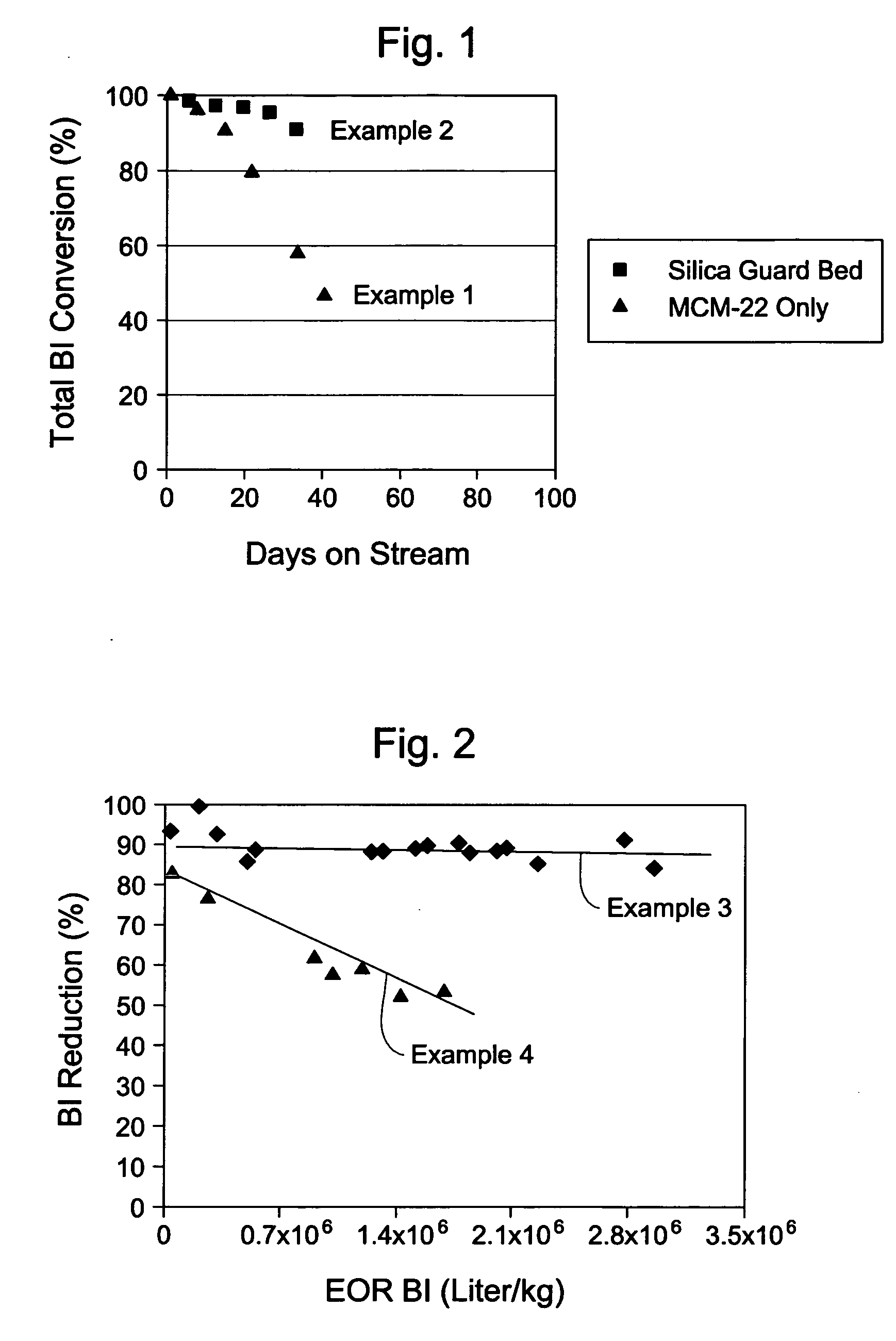Process for reducing Bromine Index of hydrocarbon feedstocks
a hydrocarbon feedstock and bromine index technology, applied in the field of bromine index reduction, can solve the problems of objectionable olefinic compounds, high price of molecular sieve materials, and unsatisfactory side reactions in downstream processes, and achieve the effect of reducing the bromine index
- Summary
- Abstract
- Description
- Claims
- Application Information
AI Technical Summary
Benefits of technology
Problems solved by technology
Method used
Image
Examples
example 1
[0073] A MCM-22 catalyst (Si / Al2=25, particle size about 1 mm) was loaded into a fixed-bed reactor. Feed A (Table 1) was pumped through the reactor at 2170 kPa-a, 232° C., and WHSV 40 hr−1. The product was sampled and analyzed for the conversion of the bromine reactive molecules in the feedstock (mostly olefins and dienes). Conversion was monitored as a function of time. The results are plotted in FIG. 1.
example 2
[0074] The experiment of example 1 was repeated with a bed of dry silica gel placed upstream of the fixed bed reactor. Feed A first passed through the silica gel at WHSV 0.2 hr−1 and room temperature before passing across the MCM-22 catalyst. The purpose of the silica gel was to remove trace oxygenates from the feedstock. The results are plotted in FIG. 1.
[0075] Analysis of feed A identified the presence of oxygenates including tetraethylene glycol solvent and plasticizers. The tetraethylene glycol was present in a range from about 21 to about 200 wppm. The silica gel is known to be an effective means of selectively removing oxygenates from the feedstock to as low as less than 5 wppm oxygenates-oxygen. As shown in FIG. 1, the examples prove that the stability of the MCM-22 catalyst for the BI reduction is dependent upon the amount of oxygenates in the feedstock. Removing the oxygenates leads to a great improvement in catalyst stability.
example 3
[0076] A MCM-22 catalyst (Si / Al2=25, particle size about 1 mm) was loaded into a fixed-bed reactor. Feed B (Table 1) was pumped through the reactor at 2170 kPa-a, 210° C., and WHSV 100 hr−1. The product was sampled and analyzed for the conversion of the bromine reactive molecules in the feedstock. Conversion was monitored as a function of time. The results are plotted in FIG. 2. The EOR BI liter / kg for MCM-22 catalyst with feed B is 2.95×106 BI liter / kg.
PUM
 Login to View More
Login to View More Abstract
Description
Claims
Application Information
 Login to View More
Login to View More - R&D
- Intellectual Property
- Life Sciences
- Materials
- Tech Scout
- Unparalleled Data Quality
- Higher Quality Content
- 60% Fewer Hallucinations
Browse by: Latest US Patents, China's latest patents, Technical Efficacy Thesaurus, Application Domain, Technology Topic, Popular Technical Reports.
© 2025 PatSnap. All rights reserved.Legal|Privacy policy|Modern Slavery Act Transparency Statement|Sitemap|About US| Contact US: help@patsnap.com


